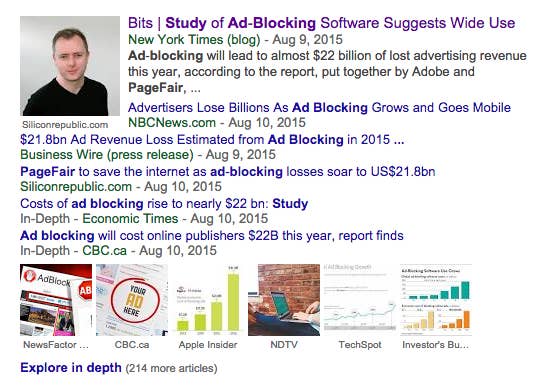
In recent weeks, multiple news outlets — including The New York Times, Fortune, and The Wall Street Journal — published stories based on a study that claimed publishers will lose $21.8 billion dollars this year due to ad blocking. The study's claims quickly sent waves through the advertising and publishing industries, parts of which applied the word "crisis" to the situation.
$21.8 billion is a scary number — certainly one large enough to justify such reactions. Except for one thing: it's not accurate.
The study — conducted by Pagefair, a company that makes money by helping publishers show ads to people with ad blockers, and Adobe — contains a fundamental methodology error that undermines its conclusions.
Specifically, the study ignored the law of supply and demand. To get to the $21.8 billion dollar figure, it assumed that the blocked ads, if added to the overall pool of ad inventory, would command the same rates as those in a market without them. But in a real world situation, if ad blocking went away, the market would flood with an increased supply of ad inventory, dropping rates for all ads and leading to a much smaller loss figure than $21.8 billion.
A word about ad blocking: the term may be a bit of a misnomer. The technology doesn't "block" existing ads but rather prevents them from ever being served. Advertisers pay for ads when they show up on a web page (called an impression) after being served. So when an ad is "blocked," the advertiser doesn't waste any money, but rather doesn't spend it. This cash remains available to spend on a smaller pool of inventory. Same cash (demand), less inventory (supply), should result in higher prices for ad inventory that remains after blocking. Those extra dollars from higher prices end up in the hands of publishers, the ones supposedly "losing" the $21.8 billion dollars
"By failing to take into account reactions in supply and demand in the advertising market, it's likely that the $21.8 billion dollar estimate is a gross inflation of the effects of ad blocking software," Joshua Gans, Professor of Strategic Management at University of Toronto's Rotman School of Management, told BuzzFeed News in an interview.
Before going further, it's worth taking a detailed look at Pagefair's methodology: the study examined ad blocking adoption rate per country, and ad revenue for that country, and assumed that if the percentage of ads blocked were available for sale, they would garner the same rates as those that were not blocked. So in the U.S. this year, where digital ad revenue is predicted to reach $58.6 billion, and the ad blocking rate is 15.4%, the study found that a total of around $10.7 billion lost due to ad blocking. That number, which assumes no drop off in inventory prices due to increased supply, is mathematically unsound.
In an interview conducted via phone and then email, Pagefair CEO Sean Blanchfield argued the law of supply and demand isn't relevant in this case. His point: demand isn't fixed in the digital advertising economy and, if given the right opportunity, marketers would be willing to spend more money. "The opportunity to advertise to sophisticated millennial users (who are highly fragmented in most other channels) is as compelling as it gets for marketers," he said, referring to a group that uses ad blocking technology in significant numbers.
That argument too is based on flawed logic. If ad block users couldn't be reached elsewhere in the digital world, it might make sense. But ad blocking today is still relatively ineffective outside of desktop web browsers; it's not yet available for use on the iPhone's Safari browser for instance, and it can't block ads in apps, where most of people's time is spent on mobile. According to eMarketer, whose numbers Pagefair relied on for its study, mobile ad spending will account for more than 50% of the entire digital advertising market. So most of digital advertisers' spending goes to media where ad blocking impact is minimal. Advertisers can then still reach ad block users, but in different places on the internet. "The pie is more like a waterbed," Gans said. "You push down, you lose one part of it, but it goes up elsewhere."
Jim Caruso, Senior Vice President of Product and Client Strategy at Varick Media Management, an automated ad buying agency, said his company has experienced little trouble reaching the people they want with ad campaigns. "We've not seen an impact on any of this stuff yet. We haven't seen some dramatic shift," he told BuzzFeed News.
Susan Athey, Economics of Technology Professor at Stanford's Graduate School of Business, told BuzzFeed News that she too believes the number is too high. "They've left out the effects that occur when the markets adjust, so the numbers would be overstated for the amount of money the industry is going to lose."
Athey argued that when ad-block makes people unreachable in some areas, like desktop web, more money will likely being spent in places they can be found, such as in-app and pockets of the mobile web. She also said that if some part of a target market is unreachable to advertisers, they will likely adjust their campaigns to reach other people who may not be part of that ideal group the advertiser initially wanted to reach, but are still worth advertising to.
"We believe that it's a figure meaningful to publishers," Blanchfield said on the phone.
When told meaningful and accurate are two different things, Blanchfield responded this way: "It feels a little semantic and I can't disagree with you. I won't disagree with your logic either. From one point of view, you have a valid perspective, looking at it from a point of view of supply and demand. These weren't literal dollars that were literally burned. But I'm also happy with our perspective, which is, in terms of viewing this as publishers and the scale of the revenue cost to publishing as an industry, this is the correct relative figure."
Make of that what you will.
Adblocking is still a major threat to the digital advertising world, and a growing one at that. And it is costing publishers money. But $21.8 billion in 2015? Not even close.
